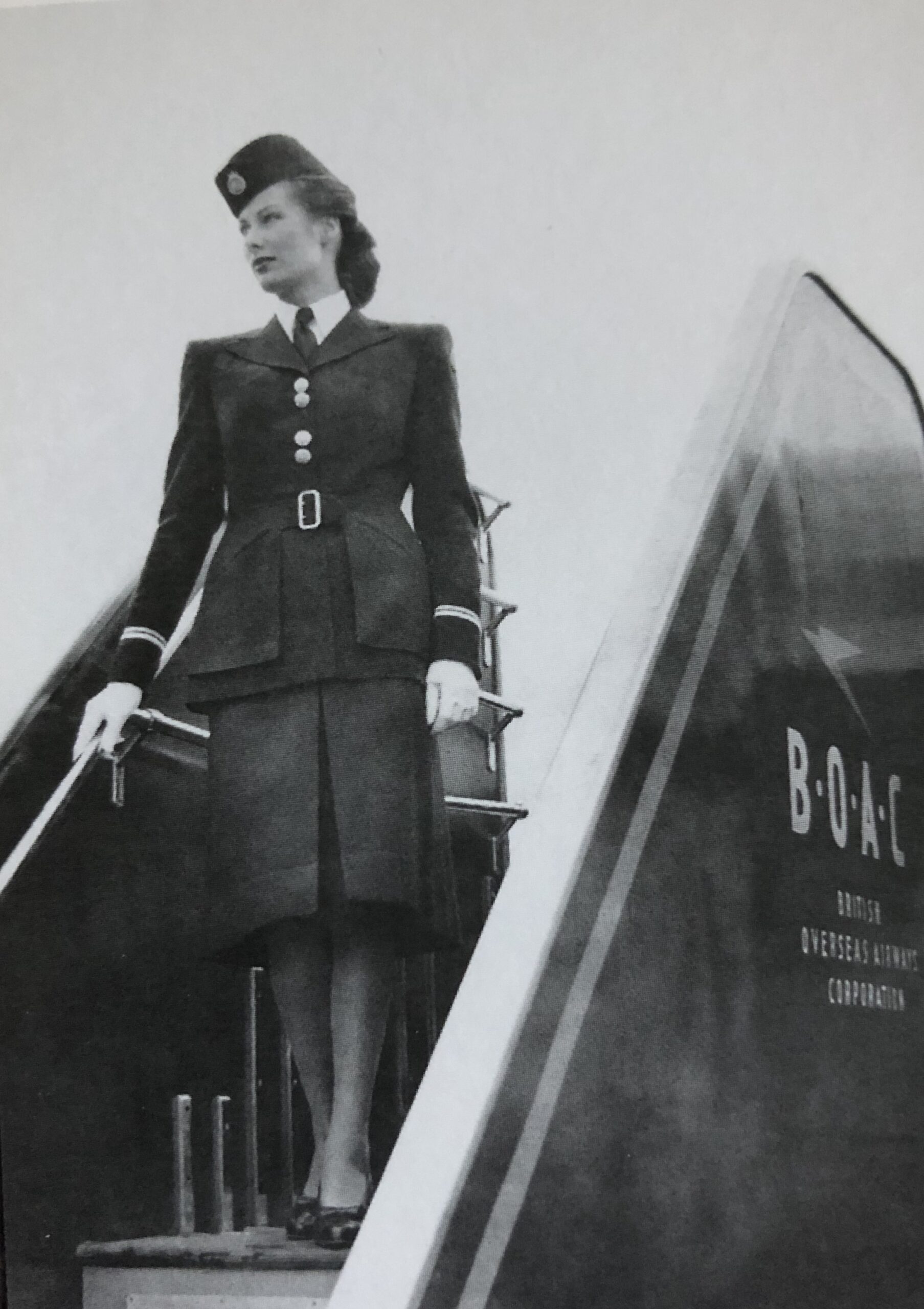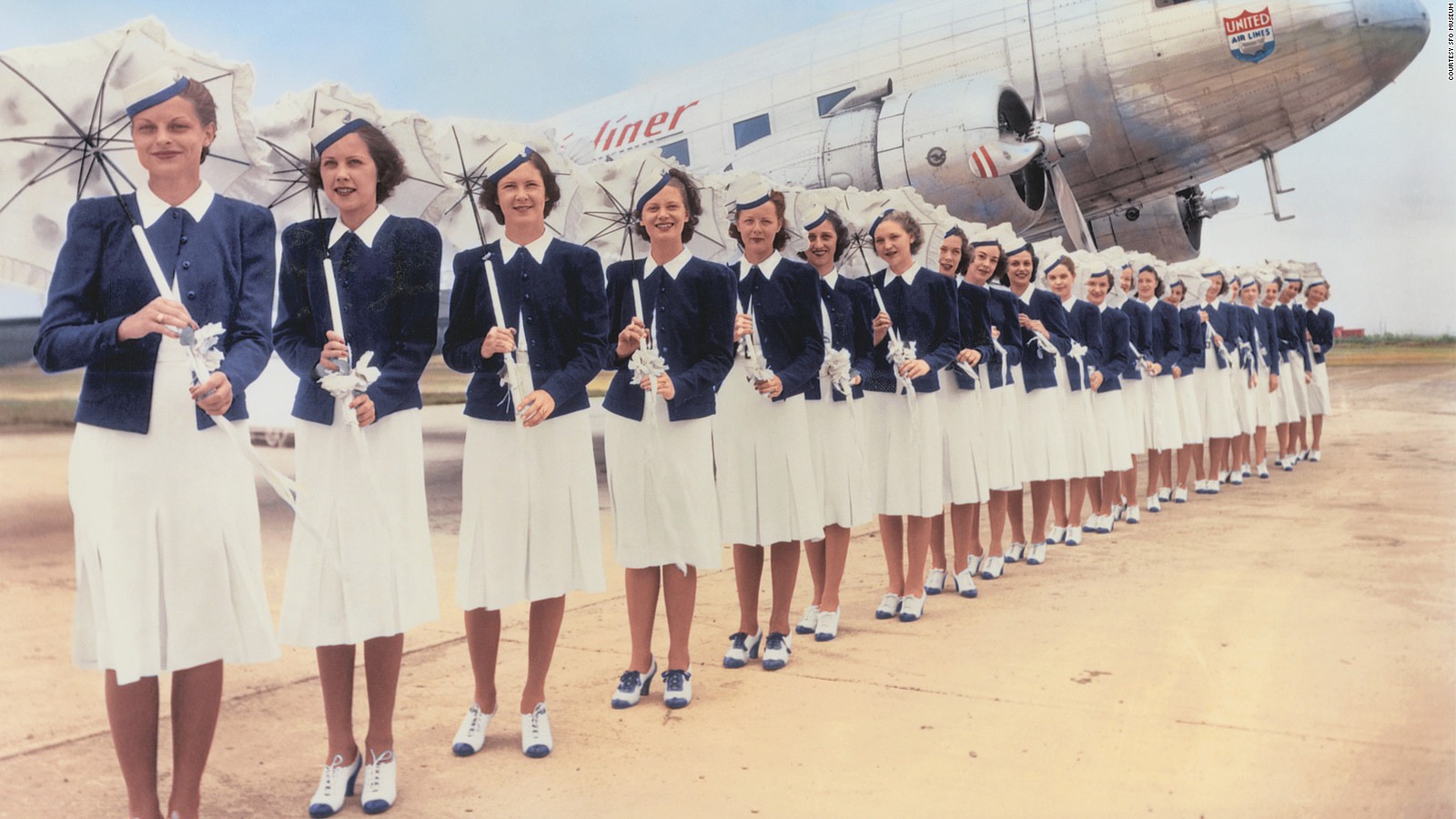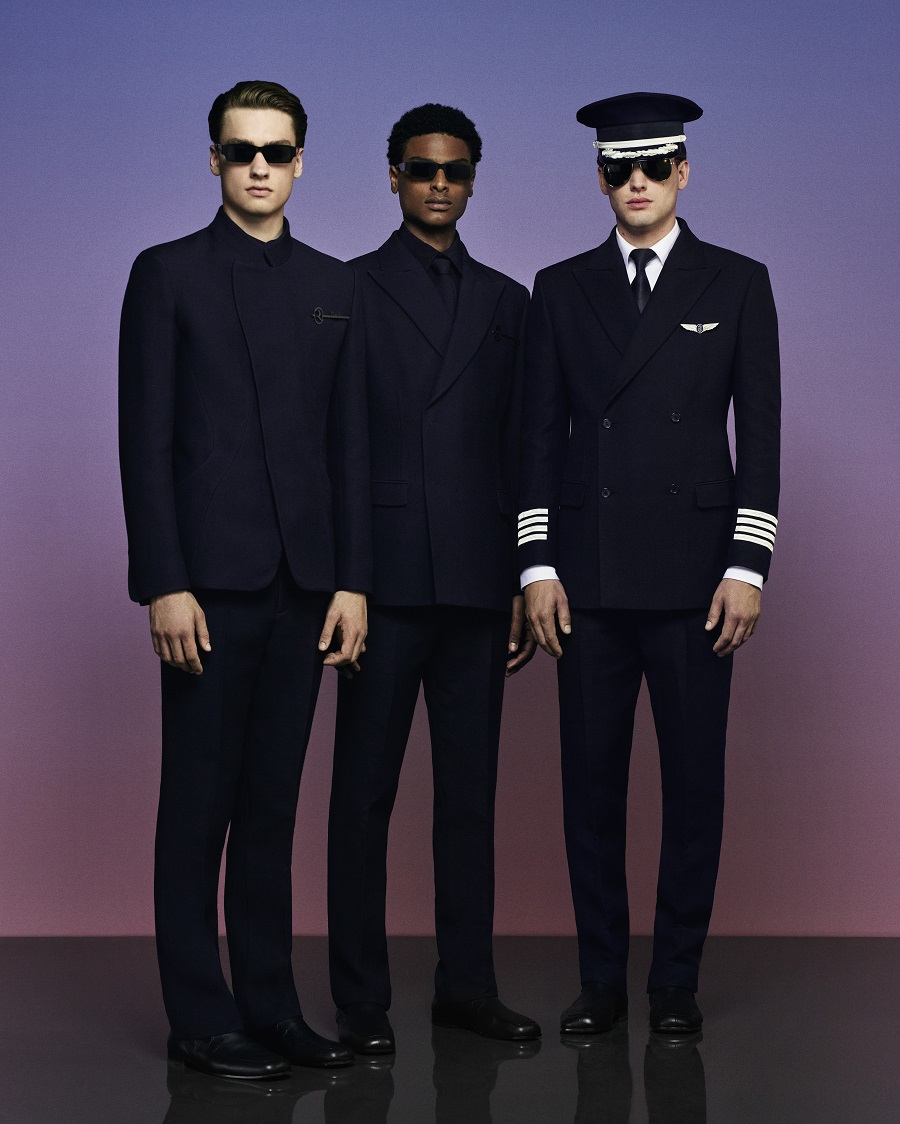News
Ladies and gentlemen, please fasten your seatbelts as we take off on a journey through the history of airline fashion – from its stylish origins in the 20th century right up to the chic dress codes of today.
1910s to 1930s: The (Not So) Humble Beginnings
![]()
It may not be universally known, but the first flight attendants were actually males back in the early 20th century. In 1912, Heinrich Kubis was technically the first flight attendant in the world, having served as a steward on the luxury German Zeppelin. He was dressed as an old-fashioned butler with a double-breasted crossover suit jacket and tie. At the time, the concept of flight attendants wasn’t a thing yet. Kubis was simply perceived to be a servant… in an airborne hotel.
Fast-forward 18 years, Ellen Church became the first female flight attendant in the world, paving the way as the catalyst for what is now a female-dominated industry. During the 1930s, onboard sickness and plane crashes were prevalent, so she pitched a sound and revolutionary idea to Boeing Air to include female nurses in their fleet. These nurses-turned-stewardesses were required to dress in a traditional healthcare-like uniform – a shower-like cap that eclipsed the ears, white gloves, a pale grey blouse, sensible black tie Oxford shoes, below-the-knee skirt and a dark green and grey wool jacket that matched the colour scheme of the Boeing 80-A. This military-reminiscent aesthetic was designed to provoke a sense of sophistication, authority, and safety for privileged but anxious passengers.
The 1940s: Aviation Fashion During WWII

World War II set off a chain of events that opened army recruitment to all ages. This naturally increased the demand for more military uniforms, causing a shortage in textiles for certain other industries, including airlines. While it might have seemed to hinder the industry at first glance, it allowed airlines to think ahead with more nuanced ideas for their stewardess uniforms.
For starters, the standard military-inspired skirt suits got a major upgrade – United Airlines as an example. Long capes and collars were no longer on the flight list. In the summer, the uniform aesthetic was completely discarded and was replaced with a chic fitted white crepe dress with a cohesive belt and a navy blue flannel jacket.

As the airline industry expanded globally, the demand for fashionable uniforms grew increasingly crucial. For British Overseas Airways Corporation, Maurice Helman made history as the first designer to produce a line of stylish crew uniforms. He took inspiration from haute couture and World War II to deliver a look that combined the essence of a soldier through a bland hues military skirt suit and tie with a touch of couture through an accentuated belted waist that echoed femininity.
The 1950s: Elegance Takes Flight
![]()
Around that time, commercial flying started to become more accessible. However, passengers still wanted to feel a sense of exclusivity. With that in mind, the airlines had no choice but to respond to the decade’s new-found desire for elegance and glamour. That’s when high fashion and aviation crossed paths.
In 1951, Air France brought in the Georgette de Trèze fashion house to translate more nuanced femininity to the stewardesses’ appearance. The new design was inspired by Christian Dior’s ‘New Look’ collection from 1947 to create a more couture-tailored fitted jacket and skirt, paired with some pumps and a beret over bouffant hair that was edited into more simplicity to refine the whole ensemble. The shrinking waist also made its way to BOAC and British European Airways as they also took a page out of Christian Dior’s book to feminise and modernise.
The 1960s: Get Ready, Jet, Go
![]()
Subversiveness defined the spirit of the 1960s, shaping a decade marked by profound societal shifts, technological breakthroughs, and revolutionary fashion.
In 1965, the fashion aviation world jetted into a dimension of vibrant colours, cropped hemlines, and more liberation. It all started when Braniff International Airways recruited Emilio Pucci to conceive a whole new line of uniforms. Pucci called it “Gemini IV”, inspired by space travel. The colour combinations of red, turquoise, lavender, orange, and lemon yellow were so delectable. They came in smocks, pleated skirts, astronaut gloves, head scarves contained by hair-protecting space helmets, and tall groovy printed boots. He even incorporated some looks that showcased head-to-toe whimsical prints–including suitcases. It was a complete departure from the perfect housewife prototype, introducing the flirtatious hostess.
Southwest Airlines got the memo too, and had their hostesses rock go-go boots and belted mini skirts in 1968. They casually strolled through the aisles of the plane with flirty smiles on their faces, serving ‘love potions’ and ‘love bites’ as per the airline’s new advert. Southwest’s overall goal at the time was to transform their hostesses into sky sirens, shamelessly luring in businessmen with fat pockets with the promise of a sweet and savoury flight.
Pan Am represented the Jet Age perfectly by embracing colour and fabulousness. Hollywood designer Don Loper designed the attendants’ uniforms which mimicked the shape of the jet with a sharp angular detailing and a light blue collar jacket. The look was paired with a matching pencil skirt, bowler-style hats, and dignified white gloves. Pan Am’s attendants were seen as the ‘Supermodels’ of the era and every girl wanted to be them.
On the other side of the globe, trousers and trapeze mini dresses were all the rage in 1960s France. Enter Cristobal Balenciaga, who assisted Air France in translating this new fashion revolution to cabin crew uniforms. He also released a summery variation of the uniform–as a crossover buttoned kimono sleeve jacket, paired with a mini skirt in baby blue and pink. This look was accompanied by a cute bow tie for effortless charm.
![]()
If we’re talking 1960s, the infamous ‘Paper Dress’, manufactured in 1967 by Joseph Lore Inc for the British Overseas Airways Corporation, certainly deserves a shoutout. It was a creamy sheath dress made from an ironically fire-proof paper-like textile that encompassed psychedelic floral prints. Designed to be fireproof, legend has it that some inebriated male passengers put the garment to the test by taking a lighter to it out of curiosity.
In Africa, Sudan Airways had a significant moment representing Sudanese culture by incorporating the DNA of traditional long-flowing thawbs for their female attendants and loose jalabiyas for the males into their uniforms in ambassadorial colour symbols of green, blue, and yellow.
1970s: Prints, Patterns and Psychedelic Pants
![]()
Everyone knows the 1970s was the decade for all things wild, colourful, and funky! All outdated restrictions were thrown out the plane, making space for psychedelic patterns, risqué short skirts, and go-go boots.
During that time, United Airlines’ uniforms were provided by renowned Oscar-winning costume designer Jean Louis. He designed a line of A-line dresses, advertised through pretty jazzy editorials that captured the imagination of the fashion world. Available in four colour combinations, the attendants had a handful of options to choose from; Hawaiian Sunset, Maliblue with a Miami Sands stripe, ivory Miami Sands with an orange Hawaiian Sunset, and dark Maliblue with stripes curved on the neck that went down the mid-front.
Over in East Asia, Hanae Mori celebrated the out-of-control 1970s by designing a navy flight suit for Japan Airlines’ flight attendants that defied the cultural norms – a controversial navy mini skirt suit. The look still maintained cultural significance with a rising sun red belt and shoe detail that gave a nod to the Japanese flag.
In 1974, Pierre Balmain entered the game with Singapore Airlines, giving their uniforms a couture upgrade. The French designer didn’t want to erase the kebaya (a traditional blouse-dress combination), but wanted to alter it for better functionality. To accomplish that, he invited See Biew Wah, a Singapore Airlines flight stewardess to model for him in Paris, and she ended up becoming a muse for one of the most renowned couturiers in the world.
![]()
After spending some time with Biew Wah, Pierre’s plan was clear. He added a slit to the bottom to tie up for ease of movement in case of emergencies. These slightly upgraded uniforms have remained the same to this day.
One of the Middle East’s most well-known carriers, Alia, currently known as Royal Jordanian, enlisted the sartorial expertise of one of the most iconic Lebanese stylists in history, Papou Lahoud. In 1976, she conceived an award-winning Italian-tailored uniform in a bold combination of electric red and beige. This look featured a fitted blazer, a thin-belted dress with a contrasting mid-front tab, a felt hat with a twist strap, and a graphic asymmetrical scarf.
1980s to 2000s: Circling Back To The Golden Days
![]()
As the world was nearing the end of the 20th century, commercial flying was increasing exponentially. The airline industry was more successful than ever but unfortunately, that came with a cost. Uniforms started to revert from fun to functional because the care of the growing volume of passengers needed to be prioritised–but they were still giving 1930s and 1950s déjà vu.
The 1980s to 2000s was all about power dressing, comfort, and functionality. Delta Airlines understood the assignment and delivered the ‘Red Wrap’ uniform in 1981. The attendants were styled in a red blazer, black skirt, white blouse, and black pumps.
Alitalia Airlines, on the other hand, had some seriously memorable fashion moments. In 1986, Renato Balestra brought in the classics in contrasting green and blue tones that blended well together in the shape of a tailored jacket with green neon piping, striped skirts, and a white top closed by a collar with a blue knot. In 1991, Giorgio Armani took a stab at updating the uniforms to match his style of double-breasted jackets in military green tones, an androgynous shirt, light pink handkerchiefs, and an over-the-knee brown skirt. After that, Mondrian’s new designs of an understated green blazer, a grey over-the-knee skirt, and a striped neck scarf soared with Alitalia for 20 years through the early 2000s.
![]()
Ethiopia’s very own Genet Kebede, a prominent designer delivered a look for Ethiopian Airlines that answered the call for current modern demand but also spoke to the richness of their heritage. The colour combinations of green and yellow were indicative of their unique culture, translated into fitted suit looks for both genders and an added range of traditional Habesha dresses with ethnic print panels for the females.
Modern Day: Only High-Fashion From Here On Out

In this day and age, over-the-top marketing stunts and avant-garde experimentation are replaced by “practical chic”. Air France’s last development of crew uniforms brought nothing less of chicness and taste, all thanks to the brilliance of Christian Lacroix who oversaw the birth of the crew’s new line in 2005. For the females, a navy blue knee-length dress with multi-topstitching on the asymmetrical panel, and styled to perfection with a big Japanese red knot for a subliminal pop. For men, it was the option of straight or double-breasted jackets. This current staple is the perfect blend of couture, timelessness, modernity, and high status.
Over in the MENA region, two major luxury airlines take the cake. One of them being Emirates, and the other being Riyadh Air. In 2009, Emirates enlisted the help of Simon Jersey, and the designers flew with the Emirates crew to New Zealand to research their occupational behaviours, workspaces, and travellers’ reactions toward other airline uniforms. All in the name of delivering the ultimate Emirates uniform that spoke to the sophistication and luxury they wanted to communicate. They accomplished that with pinstripe skirt suits in sandy desert colours, red-piped lapels, slicing on the bottom, and red hats with white draped veils. The male crew currently sports cohesive well-tailored pinstripe grey suits complemented by a multi-striped tie.
![]()
In 2024, Riyadh Air revealed its collection during the Paris Haute Couture Week, designed by Saudi creative Ashi. The aim was to bring back the golden age of travel, meaning the 1950s, with colour codes inspired by the lavender fields of the Kingdom. This concept was then alchemised into the finest cashmere wool ensembles. Come 2025, the pilots and male attendants will be dressed in crisply tailored suits and trench coats in double-breasted and crossover styles. The female attendants will be conveying nostalgia with a modern twist through a tilted pillbox hat, luminous gloves, a boatneck cropped sleeve cinched jacket with fitted pants, an oversized lapel coat, a one-piece below-the- knee form-fitting dress with futuristic curved lines, and a collar that travels gracefully around the sleeve.
We’ve now reached the end of our journey through the fascinating evolution of airline fashion. We hope you had a pleasant read. Thank you for flying with us.
Words: Khaled Alameh